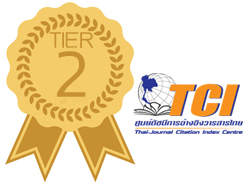Risks Hedging Technique from Gold Prices Fluctuation in Contract for Difference Trading
Keywords:
Hedging, Gold prices, Contract for difference tradingAbstract
This study aims to investigate what is the best investing strategy in gold market by comparing return on investment, hedging effectiveness and decreasing in standard deviation in three portfolios. The three portfolios include unhedged portfolio, optimal hedge portfolio and perfect hedge portfolio. Gold’s prices are collected from June 30, 2016 to July 3, 2017 covering 368 days. The gold’s price is employed to calculate the optimal hedging effectiveness ratio and the ratio is used to form those three portfolios. The investing period is from July 5, 2017 to September 27, 2017. The result shows that unhedged portfolio generates a highest return on investment at 12.83%. This result is due to an increasing in the gold price during the sample period. Moreover, this study indicates that the optimal hedge portfolio performs well to reduce the risk, which is measured by a decreasing of standard deviation, approximately 87.6439% and to generate a highest hedging effectiveness ratio at 0.9847. Furthermore, rate of return from optimal hedge portfolio outperforms a rate of return from perfect hedge portfolio.
References
Available from: https://www.ausirisgroup.com
2. Wichuta J. Affecting factors to the gold price in the world market. Journal of DPU College Innovative Business
and Accountancy. 2014; 3(2): 227-237. Thai.
3. Sutthida P. Taming Volatile Gold by Futures [Master of Science Thesis]. Bangkok:
Thammasat University; 2011. Thai.
4. Markowitz HM. Portfolio Selection. The Journal of Finance. 1952; 7(1): 77-91.
5. Johnson LL. The Theory of Hedging and Speculation in Commodity Futures. Review of
Economic Studies. 1960; 27(3): 139-151.
6. Richard DF, Jian S. Hedging and Value at Risk. The journal of futures markets.
2009; 30(8): 780-794.
7. Gang L. The Determination of an Optimal Hedge Ratio and a Generalized Measure of Risk
[MScA Thesis]. Quebec: Concordia University; 2006.
8. Hull JC. Futures and Other Derivatives. New Jersey: Prentice-Hall; 2011.
9. Abdulnasser HJ, Eduardo R. Calculating the Optimal Hedge Ratio: Constant, Time Varying.
Economics Letters. 2006; 13(5): 293-299.
10. Mihai CD, Daniel A. The Optimal Hedging Ratio for Non-Ferrous Metals. Romanian Journal of Economic
Forecasting. 2014; 17(1): 105-122.
11. Chotima T. Risk management by forward contract covering: case study: Ajinomoto Betagro Frozen Food (Thailand).
[Master of Science Thesis]. Bangkok: Dhurakij Pundit University; 2007. Thai.
12. Bhisalaxana N. Ex ante hedging effectiveness of SET50 index futures: evidence from Thailand
[Master of Science Thesis]. Bangkok: Thammasat University; 2011. Thai.




